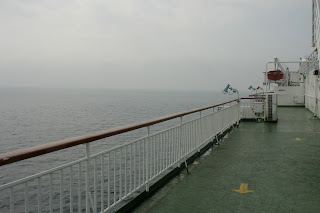 |
| The Haenyeo Divers of Jeju-do |
I had never heard of the Haenyeo divers before I went to Jeju Island. But since then I have seen them, read up on them and watched a movie based on the fictional life of one of them. Spectacular stuff. Haenyeo divers are a bunch of free diving, Korean, fishing women. Most of them were based on the island of Jeju, but there were other places around Korea where they lived and worked.
Prompted by high fishing taxes for men, the women took to the seas. Haenyeo divers fish for anything from seaweed, to shellfish, to octopus and fish. They have no oxygen tanks, just a mask, a wet suit, and a knife to pry the shells from the rocks. They have a floating buoy on the surface and a net to hold their catch. The women are known to free dive up to 20 meters and hold their breath for over 2 minutes.
In the 1950's when their numbers were at their highest, there was about 30,000 female divers. Although it was a difficult and sometimes dangerous job, there was a mark of pride to it as well. These women were usually the primary bread winners (or kimchi-winners) in their family, and in some places it went so far as the men becoming the child rearers while the women worked at sea.
Over the years the numbers have dwindled. Daughters used to start their training at the young age of just 9 or 10, where they would collect clams and abalone (Jeju is famous for it's abalone). But now, it seems an easier walk of life to grow up and work in Jeju's thriving tourism industry rather than follow in their mothers' wet footsteps. In 2002, there were just over 5000 haenyeo divers, with more than 50% being over 60 years old. Now, less than 10 years later, there is estimated to be less than 3000 divers left. Sadly, it is a dying breed.
Garry and I arrived on Jeju Island at maybe just after noon on a Saturday. We veered off the main road and ended up walking to the nearest town through empty fields and cliffs overlooking the ocean. About 15 minutes into our walk we came across 3 haenyeos all kitted up. It was an amazing sight, like we were in a time warp. The ones left have an amazing, almost ethereal presence on Jeju, like that of a mermaid. There are museums devoted to them and statues and plaques everywhere. Seafood restaurants flaunt pictures of them, so you can identify that you are supporting these people. As well, dotted along the coast, were little shacks where you could see their suits and masks hung up to dry and their nets laying empty in preparation for the next day.
 |
| One of the sites of the Haenyeo divers. |
 |
| A Haenyeo seafood restaurant |
 |
| Haenyeo divers out front of the restaurant selling their wares. |
After our trip to Jeju we watched the Korean film, My Mother the Mermaid. A little slow off the cuff but it gives you a real sense of the job the Haenyeo's did, the lives they led and the feeling of community these women had. It is a rich and fascinating part of Korea's culture and a sad one to see disappear.
There was a museum in Hado-ri, Jeju if you're interested in finding out more, but we didn't have time to make it there. Living on the mainland of Korea, I had never heard of these women before, but after a trip to Jeju Island, I feel like I have uncovered one more layer of Korea's heritage, a beautiful and interesting and captivating layer, about the integral role they played in living on Jeju-do.
 |
| Haenyeo sculpture on the seafront in Jeju City. |





























































